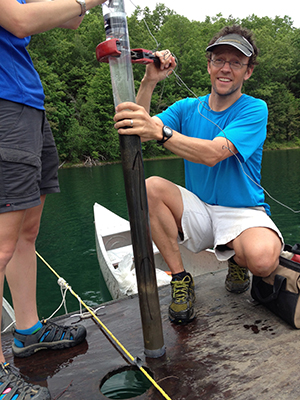UW Research Helps Show Limited Effects of Native Americans on Landscape in Pre
Published January 21, 2020

Four hundred years ago, the Pilgrims sailed to New England and encountered Native Americans. The historical narrative from that point tells of Native Americans clearing forests with fire for thousands of years before Europeans arrived in America.
Conservation efforts have widely sought to maintain natural landscapes by mimicking Native American activities with controlled burns for conservation and ecological purposes. However, the importance of burning, long assumed, has never been fully evaluated by ecological and archaeological studies.
A University of Wyoming researcher helped lead a recent study that challenged this long-held narrative and, rather, pointed to climate change as the reason New England forests changed throughout prehistory. Transformations of the New England landscape since the ice age from pine and spruce forests -- similar to today’s Rocky Mountains -- to the typical deciduous forests of today played out over millennia as the climate became warmer and wetter, not because people were modifying the landscape, the researchers found.
Bryan Shuman, a professor in UW’s Department of Geology and Geophysics, is a contributing author of a paper, titled “Conservation Implications of Limited Native American Impacts in Pre-Contact New England,” that was published Monday in Nature Sustainability, a journal that publishes significant original research from a broad range of natural, social and engineering fields.
“The article addresses landscape management and the role of Native American fires in maintaining past landscape patterns,” Shuman says. “While people have often considered that Native Americans burned wide areas and shaped much of prehistoric North America, we found that, even in one of the most densely populated regions (New England), the history of wildfires and forests had little to do with the human presence. Instead, the history of changes in forests and the frequency of wildfire was much more heavily influenced by climate changes since the last ice age.”
Wyatt Oswald, a professor in Emerson College’s Institute for Liberal Arts and Interdisciplinary Studies, was the paper’s lead author. David Foster, director of Harvard Forest and a senior lecturer of biology at Harvard University, was the paper’s second author. Other contributors to the paper included researchers from Binghamton University, the University of Massachusetts Amherst and the Public Archaeology Laboratory in Pawtucket, R.I.
The research team collected sediment cores from 21 lakes across southern New England. These were concentrated along the coast from Long Island to Cape Cod; adjoining islands (Elizabeth Islands and Martha’s Vineyard); and adjoining areas of Connecticut and Massachusetts.
The mud at the bottom of the small lakes contained layers of charcoal from ancient forest fires and pollen left behind by the region’s forest. Studying the charcoal and pollen yielded landscape-scale records of previous fires and vegetation.
Thirteen of the lake-sediment records begin between 14,000 and 9,600 years ago, according to the paper. The other eight records cover the past 1,600 to 2,000 years. The charcoal and pollen data were then compared with paleoclimate and archaeological records of the region.
Shuman, who conducted a lot of the fieldwork and collected core samples from the bottom of the lakes, says his main role was to use various geological methods to determine the climate history of the region.
“We compared the geological evidence of past climate changes with the forest history that was developed from the fossil record Wyatt and David put together,” Shuman says. “That includes charcoal, the fire history; and pollen, the trees that grew there. We combined that with the human history that the three archaeologists compiled. We determined how they intertwined with each to influence what the New England landscape looked like over time.”
It was found that, while Native Americans hunted and fished with frequency, they did not implement widespread use of fires to clear the land for agricultural purposes. It was Europeans who came later who cut down swaths of forest for farming and to produce charcoal, which was used for iron smelting, Shuman says.
“When they (Europeans) cleared the land, it opened it up for farming. It probably had a large impact on animals on the landscape,” Shuman says. “This isn’t to say that Indians were living in pristine nature. But their impacts with fire and land improvements were small. They weren’t farmers. They were hunters and gatherers.”
According to the paper, New England provided an ideal research setting to examine the team’s hypothesis. The area features a high density of sites with detailed reconstruction of postglacial climate vegetation, fire and human activity. Additionally, the area supported high concentrations of Native people beginning at least 8,000 years ago; provides some of the most widely cited early records used to formulate and support the interpretation of widespread indigenous use of fire in eastern North America; and continues to be recognized as a place where the reasons and consequences of past fire require further study.
“It is the place where there were a lot of Native Americans. There are a lot of records from early colonists,” Shuman says. “It is a place that we know had a rich history in climate change and forest change since the last ice age. It has a very diverse forest affected by the Atlantic Ocean and Gulf Stream.”
Land managers seeking to emulate pre-European contact conditions should de-emphasize human disturbance and focus on developing mature forests, according to the paper. Those seeking to maintain open lands should apply the agricultural approaches that initiated them four centuries ago.
“In terms of land management, the expectation that we use fire or tools Native Americans used is probably not the way to manage these landscapes. We don’t need to mimic what people did 400 years ago,” Shuman says. “What we see are forests are prone to change due to climate change. We should not anticipate the forests will remain the way they’ve been.”

